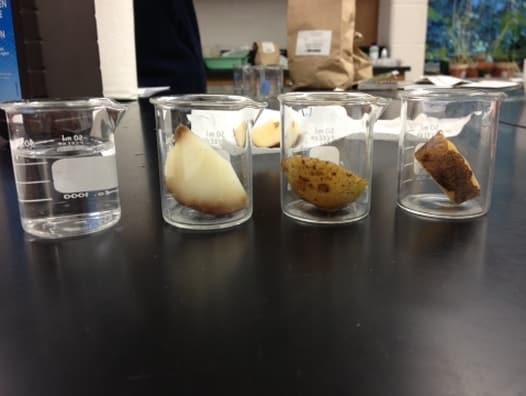What gas was produced by the breakdown of hydrogen peroxide?
Oxygen gas was produced.
Describe the test that was performed in order to identify the gas.
A glowing splint of a match was lit, blown out then inserted into the test tube. The match relighting in the test tube indicates oxygen gas is present.
Can hydrogen peroxide be broken down by catalyst other than those found in a living system?
Hydrogen peroxide can be broken down by manganese dioxide because it has catalytic properties. It is unstable which makes it very reactive. It even breaks down in the presence of light. It increases the rate of a reaction without being changed. Sand however is not able to break it down because it contains no catalytic properties.
Explain how temperature affected the enzyme’s function
Increasing the temperature increased the rate of reaction. There is higher energy when heated. The enzyme was able to catalyze the reaction more quickly. This is only until the point until denaturation. At 40 degrees, the enzyme would experience denaturation causing the rate of reaction to drop. The enzyme would be damaged and not be able to perform the same way.
How did particle size affect the rate of reaction?
The smaller size of particles increased the rate of reaction because smaller particles consume less energy than larger ones to break down molecules, therefore the reaction would happen faster. Larger particles decreased the rate of reaction because they require more energy to break down.
Explain why there is a difference in the rates of reaction between the liver and the potato
The liver contains more of the enzyme catalase, which breaks down hydrogen peroxide. The liver contains more because it detoxifies substances in the body. A larger amount of catalase lowers the activation energy, therefore speeds up the rate of reaction. The potato contains less of the enzyme catalase, therefore requires more activation energy, slowing down the rate of reaction.
Show the fully labeled balanced chemical equation for the decomposition of hydrogen peroxide
2 H2O (aq) –(catalase)—> 2 H2O (l) + O2 (g)
hydrogen peroxide enzyme water oxygen gas
Why is it possible to use dead cells to study the function of this enzyme?
Although the cells are dead, catalase still remains active. It remains active in certain temperatures up until the point of denaturation which occurs above 40 degrees. The organism which contained the cells is gone but the cells are still present and active in certain conditions.


thanks
Thanks!
sweeet!
The enzyme discussion is amazyingly discuss clearly…
This helped me a lot. Thank you very much
Hypothesis: Liver will have better catalyse activity.
Independent ?
Dependent ?
Helpppp please 🌝
this was very helpful because it was well explained
this was very helpful because it was well explained
It was nice but you explain less on catalase in potato